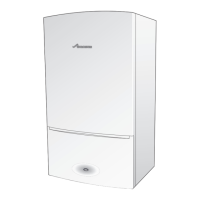
Do you have a question about the Worcester Greenstar i System ErP Series and is the answer not in the manual?
Explains symbols for actions, references, and list entries used in the manual.
Details critical safety warnings (danger, warning, caution, notice) and general safety advice.
Outlines compliance for gas safety, electrical, building regulations, and British standards.
Provides a general description of the appliance and its standard package components with diagrams.
Lists detailed specifications, performance data, and electrical information for Natural Gas models.
Presents product data for energy efficiency in accordance with EU regulations for Natural Gas.
Illustrates the main appliance components and provides a key for identification.
Shows the wiring connections for the appliance's electrical system with component labels.
Details procedures for flushing and cleaning the heating system before installation, including water treatment.
Specifies electrical and gas supply requirements, IP ratings, and wiring regulations for safe installation.
Covers requirements for plastic pipework, primary system connections, and sealed system filling procedures.
Defines necessary clearances for installation, servicing, access, and compartment requirements for safe operation.
Guides on the correct installation and routing of the pressure relief valve discharge pipe to prevent hazards.
Explains the appliance's siphonic trap and methods for condensate pipe work and disposal to prevent freezing.
Lists available optional accessories for the appliance, such as filters and kits.
Details pipe dimensions and connections for external diverter valves and controls, including optional kits.
Describes flue system types, effective lengths, and installation considerations for horizontal and vertical flue options.
Specifies minimum clearances for flue terminal positions to avoid combustion product entry and nuisance.
Details clearances and requirements for plume management system installation to control exhaust discharge.
Provides guidance on safe lifting, carrying, unpacking, and general handling of the appliance.
Covers fixing the wall mounting frame and preparing flue openings for correct appliance installation.
Details the process of making gas, water, and condensate pipework connections, including sealing.
Explains how to remove the appliance's front panel for access to internal components.
Guides on safely hanging the appliance onto the wall mounting frame by the centre hook.
Describes how to reposition the pressure relief connector after mounting for correct operation.
Details how to access and remove the appliance's siphon for cleaning or replacement.
Explains the procedure for re-fitting the siphon after removal, ensuring correct engagement.
Instructs on how to fill the siphon with water before appliance operation to ensure it functions correctly.
Covers the installation of the flue turret or adaptor for different flue configurations and pipework.
Details mains voltage and low voltage connections for appliance controls, timers, and sensors.
Explains wiring for external controls and the appliance's wiring centre, including power supply.
Lists essential checks to be performed before starting the commissioning process, including pipework and gas connections.
Outlines the procedure for filling and pressurising the heating system, including venting radiators.
Covers requirements for system flushing, inhibitor addition, and water treatment products to protect the system.
Guides on the initial start-up procedure, button functions, and what to expect on the appliance display.
Details the sequence of displays shown during the appliance's initial start-up, including internal tests.
Explains how to access and interpret appliance status codes and information menus for operational data.
Provides instructions for checking and verifying gas inlet pressure at the appliance using a manometer.
Details the procedure for setting the appliance to maximum output and testing the gas rate for correct operation.
Advises on using leak detection agents to check for gas leaks during operation and electrical wiring safety.
Explains controls for hot water temperature and pre-heat function with optional diverter valve kit for user comfort.
Outlines mandatory checks for combustion and flue integrity, including a flow chart for guidance.
Details how to check the flue system's integrity using analyser sample points for safe exhaust discharge.
Explains the procedure and requirements for performing flue gas analysis and checks for optimal combustion.
Describes how to set and manage the appliance's service reminder function for scheduled maintenance.
Provides information required for completing the Benchmark Commissioning Checklist for compliance.
Explains configuration settings for weather sensor accessories and basic weather compensation.
Details the functionality and settings available within the boiler settings menu for appliance configuration.
Allows adjustment of boundaries for values set in the Boiler settings menu, defining operational limits.
Covers final steps after commissioning, including panel replacement and fitting.
Instructions for replacing the appliance's front panel after servicing, ensuring proper seating.
Guides on how to fit the appliance's facia flap, aligning hinges and slots.
Details how to install the appliance's bottom panel, ensuring secure engagement.
Explains how to adjust the central heating flow and economic temperatures via the control panel.
Describes setting the economic flow temperature for optimal energy efficiency.
Guides on setting cylinder hot water temperature with the optional diverter valve kit for domestic hot water.
Sets the maximum temperature for the hot water cylinder to 50°C for domestic hot water supply.
Explains how to activate Eco and Preheat modes for hot water cylinder management based on demand.
Details how to enable or disable basic adjust mode to lock functions and prevent accidental adjustments.
Covers final procedures for handing over the appliance to the customer, including operation and safety.
Outlines the terms and conditions of the appliance's guarantee against faulty materials or workmanship.
Explains how basic adjust mode affects service functions and the need to disable it for servicing.
Provides general guidance for carrying out routine inspection and servicing of the appliance, including checks and records.
Describes how to access and interpret stored information on errors, service requests, and operating times via the History menu.
Details how to access and perform component tests for checking the operation of various parts.
Guides on checking flue joints, terminal, and guard for damage and obstructions to ensure safe exhaust.
Instructs on verifying gas inlet pressure against specified readings for correct appliance operation.
Explains how to perform a fan pressure test to assess the heat cell's condition and identify issues.
Details the procedure and requirements for performing flue gas analysis and checks for optimal combustion.
Covers the process of cleaning the appliance's siphon and heat exchanger for efficient operation.
Provides steps for accessing and cleaning the siphon, ensuring it is free from debris.
Details how to remove outer panels to access appliance components for maintenance or replacement.
Explains how to remove and replace parts related to the siphon, including careful handling.
Guides on how to gain access to the appliance's siphon by removing covers.
Details the procedure for safely draining the appliance before component removal to prevent water damage.
Explains how to remove the fan assembly from the appliance, including electrical and pipework disconnections.
Guides on removing the air/gas manifold clamping plate, including electrical and sensor disconnections.
Details the process for removing the burner and electrode assembly for cleaning or replacement.
Explains how to remove the flow pipe from the heat exchanger, including releasing clips.
Guides on removing the top and lower baffles from the heat exchanger, noting the use of special tools.
Details how to remove the upper and lower exhaust assemblies, including support rings.
Explains the procedure for removing the heat exchanger, including gas valve and pipework disconnection.
Covers the re-assembly of the air/gas manifold clamping plate and associated checks for sealing and tightness.
Guides on removing and replacing the primary sensor, including paste application.
Explains how to remove and replace the overheat thermostat, ensuring correct positioning.
Details the process for removing and replacing the spark generator, including bracket alignment.
Guides on removing and replacing the flue overheat thermostat, noting housing care.
Details the removal and re-assembly of the fan assembly, including mixing unit and seals.
Explains how to remove and replace the gas valve, including electrical and pipework connections.
Guides on how to remove and replace the expansion vessel, ensuring correct alignment and tightness.
Explains how to replace the PCB fuse, noting the location of spare fuses.
Details the procedure for replacing the appliance's control unit, including HCM transfer.
Guides on removing the HCM from the control unit for transfer to a new unit.
Explains how to remove the control box, including cable strain relief and retainers.
Covers the removal of the pressure gauge indicator and electrical connections, noting care for the capillary.
Details the removal of various components from the hydraulic block, including sensors, valves, and pump.
Guides on removing and refitting the auto air vent, noting 'O' ring placement.
Explains how to remove and replace the diverter valve motor, ensuring it's in mid position.
Guides on removing and refitting the diverter valve, including cleaning the valve chamber.
Explains how to remove the drain tap from its housing.
Details how to remove the pump head, including electrical and screw disconnections.
Guides on removing the pressure gauge, noting care for the capillary and head.
Explains how to remove the CH pressure relief valve from the hydraulic block.
Guides on removing the bypass valve from the hydraulic block housing.
Lists common spare parts for the main appliance and integral diverter valve kit with part numbers.
Introduces locking/blocking errors, cause codes, and maintenance codes for effective fault diagnosis.
Describes how locking errors are indicated on the display and the initial reset procedure.
Explains blocking errors, their automatic clearing, and how conditions change to locking.
Details the meaning of cause codes indicated by 'H' followed by a number for fault identification.
Lists examples of maintenance messages found in the History menu for proactive checks.
Lists maintenance messages, their cause codes, descriptions, and possible causes/checks for troubleshooting.
Provides a table of error codes, their descriptions, and possible solutions or checks for appliance faults.
Lists resistance values for various sensors and components at different temperatures for diagnostic checks.
Provides resistance data for the flow temperature NTC sensor at various temperatures.
Lists resistance data for the DHW NTC sensor at various temperatures.
Provides resistance data for the flue overheat thermostat at different temperature states.
Lists resistance data for the overheat thermostat at different temperature states.
Provides resistance data for the outdoor weather compensation sensor at various temperatures.
Lists resistance data for the cylinder temperature sensor at various temperatures.
Provides resistance values for the gas valve connections for testing.
Illustrates the central heating operational sequence, including ignition and fault conditions.
Shows the operational sequence for hot water cylinder function with the diverter valve kit for DHW priority.
Details the appliance's frost protection, pump overrun, and antiseize functions for system protection.
Explains how the appliance's internal frost protection operates by monitoring primary temperature.
Describes the pump overrun function for central heating to dissipate residual heat.
Explains the pump overrun function in case of a locking error to prevent pump damage.
Details the pump's antiseize function to prevent seizure by running periodically.
Guides on how to reset all appliance settings to factory defaults via the menu.
Explains the process of removing the integral diverter valve kit and performing a factory reset.
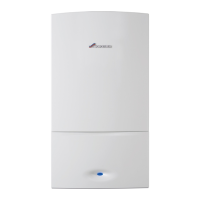
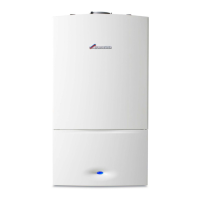





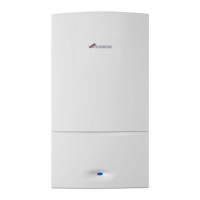
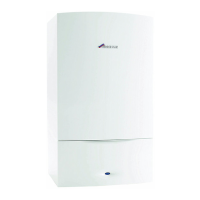
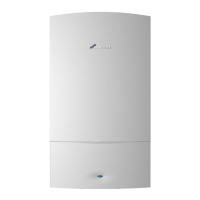
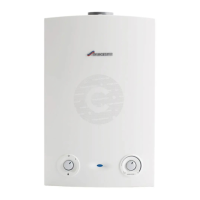
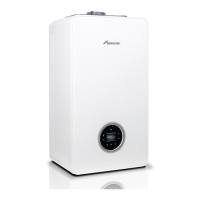
